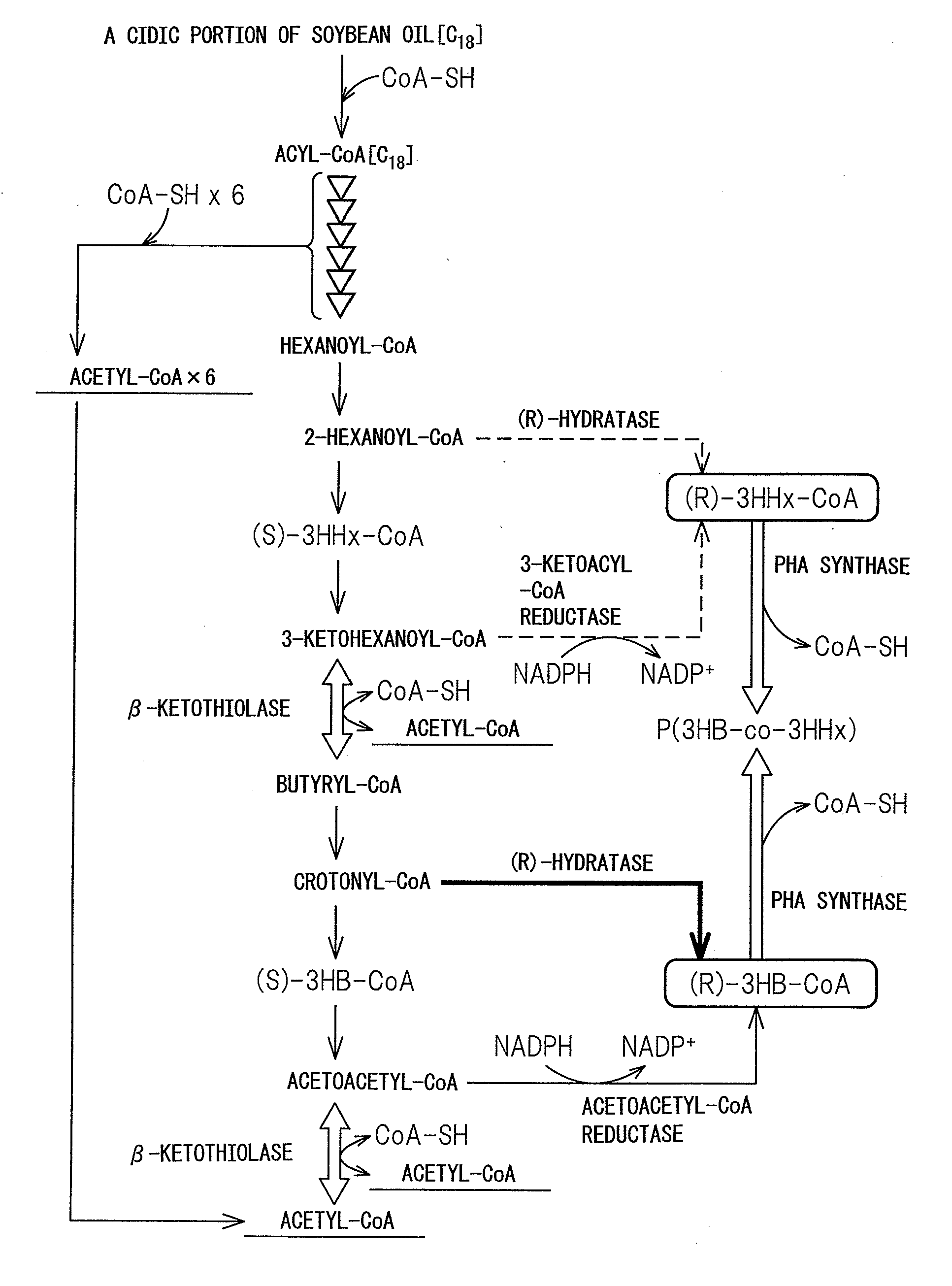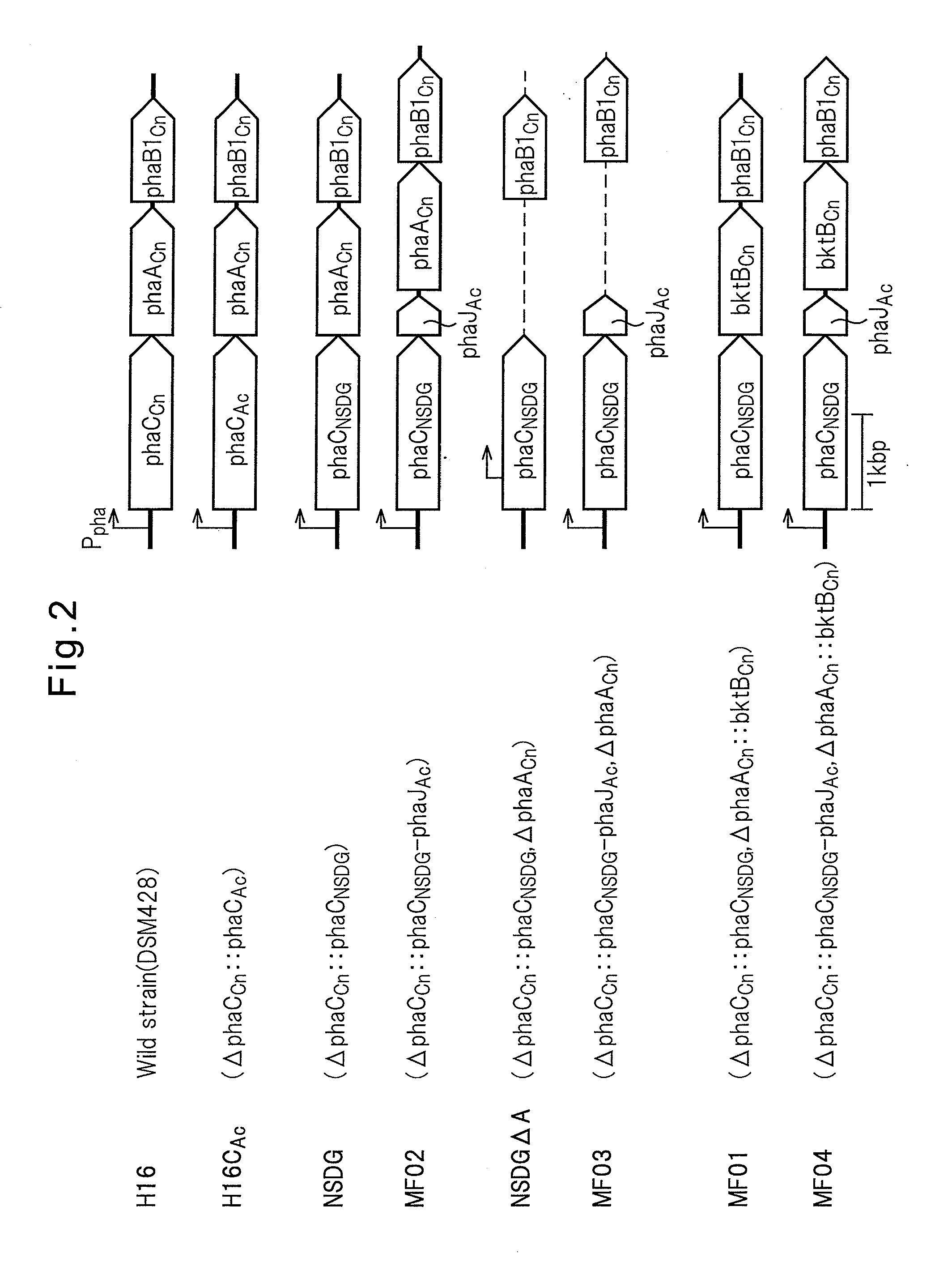PROCESS FOR PRODUCTION OF POLYHYDROXYALKANOIC ACID USING GENETICALLY MODIFIED MICROORGANISM HAVING ENOYL-CoA HYDRATASE GENE INTRODUCED THEREIN
a technology of enoylcoa hydratase and polyhydroxyalkanoic acid, which is applied in the direction of lyases, biochemical apparatus and processes, fermentation, etc., can solve the problems of difficult practical use of p(3hb), low intracellular content, and difficult disposal of p(3hb), and achieve high pha productivity, high 3hhx fraction, and high growth ability
- Summary
- Abstract
- Description
- Claims
- Application Information
AI Technical Summary
Benefits of technology
Problems solved by technology
Method used
Image
Examples
example 1
C. necator Strains Used
[0125]In the Examples below, as a host for gene recombination, C. necator strain H16 (wild type, DSM428), strain H16Δ in which a PHA synthase gene phaCCn is deleted on the chromosome of the strain H16 (Mifune, J. et al., Can. J. Chem. (200), 86:621), and strain H16CAc strain (Mifune, J. et al., supra) in which the PHA synthase gene phaCCn, on the chromosome of the H16 strain is replaced with the PHA synthase gene phaCAc derived from a soil bacterium A. caviae.
example 2
Cloning of a Doubly Amino Acid-Mutated PHA Synthase Gene
[0126]Mutant enzymes in which two amino acid mutations were introduced in the PHA synthase derived from A. caviae are reported (Tsuge, T. et al., FEMS Microbiol. Lett (2007), 277:217-222; Kichise et al., Appl. Environ. Microbial. (2002), 68:2411-2419; Kokai (Japanese Unexamined Patent Publication) No. 2008-29218). As used herein, the mutant PHA synthase gene may be termed as “phaCNSDG.” Using pBBREE32-NSDG (Tsuge, T. at al., supra) in which phaCNSDG was cloned as the template, phaCNSDG was amplified by a PCR method with the oligonucleotides of the following sequence 1 and sequence 2 as the primers. Using the KOD Plus for PCR (manufactured by Toyobo), a cycle comprising 20 seconds at 98° C., 15 seconds at 61° C. and 2 minutes at 68° C. was repeated for 30 cycles.
Sequence 1:(SEQ ID NO: 5)GGTTCGAATAGTGACGGCAGAGAGACAATCAAATCATGAGCCAACCATCTTATGGC(underlined is the Csp45I restrictionenzyme site)Sequence 2:(SEQ ID NO: 6)AACCTGCAGGCCTG...
example 3
Construction of Vector for Introducing the Doubly Amino Acid-Mutated PHA Synthase
[0128]pTA2NSDG was cleaved with Csp45I and SbfI to isolate a gene fragment containing pha2NSDG. Subsequently, pTA2C′AB (Mifune, J. et al., supra) containing a recombinant pha operon (promoter region-phaCAc-phaACn-phaB1Cn) was cleaved with Csp45I and SbfI, the 5′-end was dephosphorylated with alkaline phosphatase (manufactured by Toyobo), and then the previously obtained phaCNSDG fragment was inserted to obtain pTA2NSDG-AB. Herein, phaB1Cn is an acetoacetyl-CoA reductase gene on the chromosome of C. necator strain. By cleaving pTA2NSDG-AB with BamHI, a 5.0 kb gene segment harboring the promoter region-phaCNSDG-phaACn-phaB1Cn was isolated. Also, pK18mobsacB (Schafer et al., Gene (1994), 147:198) was cleaved with BamHI, and the 5′-end was dephosphorylated with alkaline phosphatase. Using the Ligation High, two fragments were ligated to construct pK18 msNSDG-AB.
PUM
| Property | Measurement | Unit |
|---|---|---|
| pH | aaaaa | aaaaa |
| temperature | aaaaa | aaaaa |
| temperature | aaaaa | aaaaa |
Abstract
Description
Claims
Application Information
 Login to View More
Login to View More - R&D
- Intellectual Property
- Life Sciences
- Materials
- Tech Scout
- Unparalleled Data Quality
- Higher Quality Content
- 60% Fewer Hallucinations
Browse by: Latest US Patents, China's latest patents, Technical Efficacy Thesaurus, Application Domain, Technology Topic, Popular Technical Reports.
© 2025 PatSnap. All rights reserved.Legal|Privacy policy|Modern Slavery Act Transparency Statement|Sitemap|About US| Contact US: help@patsnap.com



